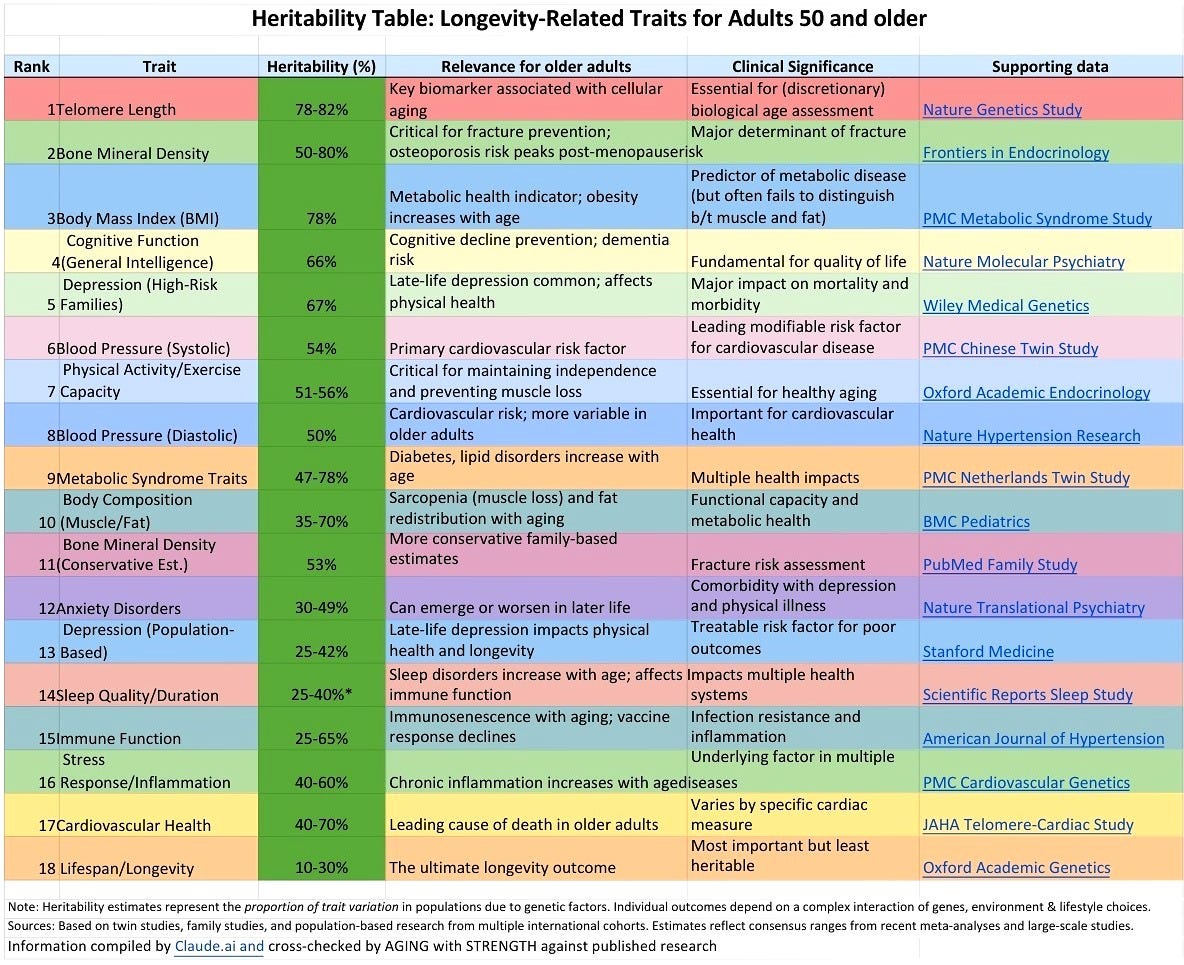Creatine and heritability: Friday thoughts
Also: "The Week In Disinformaging," a new recurring highlight of longevity-related b.s.
In this edition of Fun Friday, I respond to an AGING with STRENGTH subscriber’s request to set the record straight about creatine for older adults; feature a novel (downloadable) chart portraying human trait heritability that is important for people over 50; and introduce a new word into the English vernacular — disinformaging.
Let’s start with the most entertaining of the three, because there’s no shortage of longevity chiselers eager to take money out of your pocket and put it into theirs.
But first, in case you missed it:
1 | The week in disinformaging: Peter Rahal of David Protein
dis·in·form·ag·ing, n. intentionally communicating aging- or longevity-related b.s. for the express purpose of aggrandizing oneself or selling a product or service.
This week’s disinformaging spotlight features Peter Rahal, the co-founder and CEO of David Protein, which recently began selling frozen cod fillets for $55 each, in addition to $40 packs of 12 protein bars. Notably, David Protein recently closed a $75 million funding round from venture capital firms and health and wellness influencers Peter Attia and the known longevity chiseler Andrew Huberman.
In an interview Friday with The Wall Street Journal, Rahal makes several self-serving, false assertions about health, diet and nutrition in the course of schilling his $55 frozen cod, which your local grocery store sells (fresh) for about $8. To be sure, this is not strictly an example of aging-related misinformation, but I’m including it because so many of Rahal’s statements are bald-faced marketing crapspackle that I felt compelled to respond on behalf of truth-seeking humans everywhere.
Here are Rahal’s P.T. Barnum-like claims, pulled verbatim from the WSJ piece, with my rebuttal below each:
Peter Rahal: “Ultimately, people want an easy way to get protein, because it turns out it’s quite hard.”
AGING with STRENGTH rebuttal: Getting protein is not hard. A quarter of every product in the supermarket nowadays is now fortified with protein, from milk to skin lotion to bottled water. Also, what’s hard about opening a $0.99 can of chickpeas or beans? Alternatively, cooking that $8 grocery-store cod filet takes about 10 minutes.
Rahal: “Most of the conversations on nutrition are often really emotional, and we think it’s important to have an intellectual view. People use buzzwords and binary thinking: “Processed is bad, natural is good,” and that frame is just outdated or unhelpful. Nearly everything we eat is processed anyway, and you need it for food safety, so it’s just not helpful. What actually matters is what’s in the food.”
rebuttal: Many silly assertions in Rahal’s quote here.
Most nutrition conversations are not emotional at all but rather thoughtful and dry. Know what’s emotional? Conversations about $55 cod filets.
“processed is bad, natural is good” is “unhelpful” only to David Protein venture capital investors, and Mssrs. Attia and Huberman. In fact, ultra-processed food kills more Americans than cancer and car accidents combined.1
“nearly everything we eat is processed anyway.” Here, Rahal’s logic seems to be, “since you’re eating like crap anyway, just buy my crap.” Somebody get that man a comms manager.
Rahal: “If you’re sitting at home all day and have all the time to prepare fresh foods, great—that should be the way to eat. No one’s arguing that. But it turns out it’s really hard to do that, and it turns out it’s really expensive, and it’s hard to get that amount of protein.”
rebuttal:
“all the time to prepare fresh foods”? Dude, it takes 10 minutes to prepare a $4 meal with more protein than your $55 chunk of frozen cod.
It’s not hard or “really expensive.” (Guess what’s expensive! $55 frozen cod.)
Almost everything in Rahal’s statement is a load of ultra-processed, venture-backed nonsense.
2 | Heritability: An important concept in aging and longevity
I’ve been reading “Adaptable,” by Herman Pontzer, a book about how the human body functions at every level of biology. Early on, Pontzer introduces the concept of heritability in discussion of how each of us acquires our variable traits — eye and hair color, immune function, sense of humor, health span, etc.
Turns out heritability is, as Pontzer notes, a notoriously slippery concept in biology. To quote Inigo Montoya in “The Princess Bride”: “I don’t think it means what you think it means.”
At first, I thought heritability means the likelihood that genes account for any given aspect of our individual biology. After all, the concept of inheritance is fairly straight forward. But that’s not what heritability means. Rather:
Heritability is a measure of how much the differences in a trait among people in a population are due to differences in their genes, rather than differences in their environment or lifestyle.
Earlier this week, I asked Claude.ai to create a heritability table showing the top 20 most heritable human traits, in descending order of heritability, that would be of significant interest to people over age 50. I asked the AI to provide links to each trait’s heritability percentage, so I could verify it’s accuracy. Below is that chart.

Why am I telling you about heritability? Because it provides an understanding how much leverage we may have to alter aspects of ourselves that may otherwise be considered unchangeable because….genes! Genes are not destiny, especially when it comes to predicting your longevity. Turns out, Claude.ai gave me only 18 of the most heritable human traits and the lowest among them is “lifespan/longevity.”
Translation: What we do in the course of our lives determines most of our longevity and health span outcomes. So keep going, keep trying new ways to improve your health and well being.
3 | Creatine, beyond the hype
An AGING with STRENGTH subscriber asked me to investigate the benefits of creatine for older adults, and specifically the idea that creatine use can hurt kidney function.
What is creatine?
Creatine is a naturally occurring compound that serves as a crucial energy source for your muscles and brain. It’s also an increasingly popular supplement that people who regularly lift weights or engage in high-intensity training use to develop lean body mass and help their muscles recover. Creatine is found most commonly in foods like meat, seafood and cow’s milk. Our bodies can make creatine from three other true amino acids: arginine, glycine and methionine.
Is creatine safe?
Generally speaking: Creatine supplements — which are not regulated by the FDA and thus claims by its manufacturers cannot be independently verified — are considered safe to take for healthy women and men, even older adults, in the proper doses for the proper reasons.
The idea that creatine impaired kidney function in otherwise healthy adults without renal disease is unfounded.
Should you take creatine?
Keep reading with a 7-day free trial
Subscribe to AGING with STRENGTH® to keep reading this post and get 7 days of free access to the full post archives.



